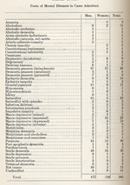In
1910 in Vermont the two principle institutions for mental patients were
the Brattleboro Retreat, a private institution, and the Vermont State
Hospital for the Insane at Waterbury. By the end of the first decade of
the 20th century, people had begun to perceive mental hospitals as hospitals,
rather than as asylums; this perception, as well as a new law stating
that the criminals awaiting trial could be sent to hospital for observation,
meant that more and more insane persons were being admitted and treated
at these institutions. Also at this time, changes to and recommendations
for the current legislative proceedings regarding voluntary, involuntary,
and criminal commitment were made, paying close attention to patients’
interests.
At Brattleboro, the most frequent forms of curable disorders treated during the biennial ending in June, 1910 were alcoholism, melancholia, and mania. The most frequent forms of incurable disorders were paranoia, senile dementia, and delusional insanity. A new gymnasium and amusement center were under construction during this period, and much attention and renovation efforts were focused on fire-safety and the installation of a sprinkler system throughout the institution.
During this same period, the Vermont State Hospital (VSH) was nearly full to capacity (600 patients), and especially crowded were the criminal wards (by law, the criminally insane had to be kept separate from non-criminal patients). As a result of the inadequate space, if (non-criminal) patients had a prognosis of being “normal” for a minimum 6 month period, they were discharged.
Patient care was advancing at the time as well, and the hospital had recently instated “outdoor” and “non-restraint” policies. The “outdoor” policy included the construction of verandas on most of the wards, exercise outside twice daily in the summer, and sleigh rides in the winter. The “non-restraint” policy prohibited “padded cells,” and also stated that the least amount of mechanical restraint possible should be used when patients were over-excited. For the purpose of more quickly and gently calming patients, Superintendent Don D. Grout requested from the board of trustees approximately $1,000 to purchase a Continuous Bath Apparatus, an important development in hydrotherapy.
Patient activity and recreation remained largely unchanged from the opening of VSH, and included useful employment (such as on the hospital’s prosperous farm), religious services, dances, movies, reading in the library, and exercising in the gymnasium. The superintendent requested the construction of a greenhouse to add to the hospital’s profitable garden, and this too could provide patient employment opportunities.
The two year training school for nurses was also continued, and included weekly lectures by a medical staff member, as well as recitations or demonstrations by the superintendent of nurses.
Despite advancements in both patient care and nurses training, VSH suffered not only from the overcrowding that existed in the biennial between 1908 and 1910, but also from two disastrous fires, each of which left hospital staff in a state of chaotic embarrassment. The first fire was a result of defective wiring in one of the wards, while the second fire occurred in the paint-shop where turpentine, oil, varnish, paint remover, and other highly flammable substances were stored. Neither fire was allowed to spread very far, and the damages were contained and quickly repaired. Grout requested an emergency fund for any similar events that may occur in the future.
